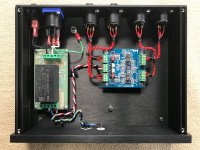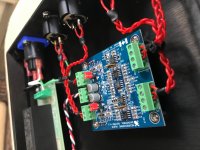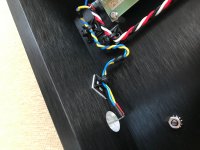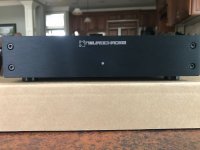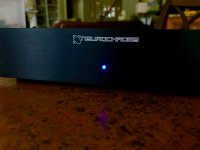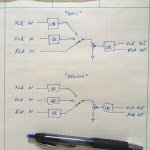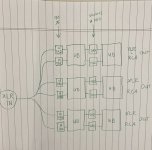Looks like my 1st link is blocked above. Search:
Self Driving 2016 Civic SQmobile: iOS | USB/SPIDF | Tubes | 3 DSP’s | Dirac
On DIYMA
You’ll notice I have talked about the same Comma Ai platform I use in the build on a thread on this forum too:
Self driving cars are here. Thoughts?
(Starting with post #68)
Self Driving 2016 Civic SQmobile: iOS | USB/SPIDF | Tubes | 3 DSP’s | Dirac
On DIYMA
You’ll notice I have talked about the same Comma Ai platform I use in the build on a thread on this forum too:
Self driving cars are here. Thoughts?
(Starting with post #68)
Last edited:
I didn’t fully get what you you meant at first.
In regards to this specific quote, I am referring to using DSP products in car audio setups. These are often necessary in vehicle which is just about the worst listening environment imaginable. DSP allows us to change things in the time domain, make custom crossovers, align phase of drivers in multi way setups to play as cohesive as possible at the driver seat to place the best stage possible on the center of the car dash. Nearly all The leading automotive DSP products allow users to also adjust individual channel gains. So that makes amp gain pot becomes redundant. Hence the answer to the proposed question of why no gain pots on certain Biketronics amps.
""
Audiophile straight amp with no XO, or gain pot stage, to contaminate the sound in any way.
They can set the input voltage to whatever your headunit or DSP output voltage is. To ensure you get the amp powered to full tilt. (It can be changed just has to be sent in to them to do so). Don’t forget there is a lifetime warranty.
But nowadays with DSP’s in the mix. a gain nob isn’t quite necessary. Individual channel gain can be adjusted via DSP instead. ""
In regards to this specific quote, I am referring to using DSP products in car audio setups. These are often necessary in vehicle which is just about the worst listening environment imaginable. DSP allows us to change things in the time domain, make custom crossovers, align phase of drivers in multi way setups to play as cohesive as possible at the driver seat to place the best stage possible on the center of the car dash. Nearly all The leading automotive DSP products allow users to also adjust individual channel gains. So that makes amp gain pot becomes redundant. Hence the answer to the proposed question of why no gain pots on certain Biketronics amps.
Sure is! Mods feel free to delete any of my posts. I’m still eagerly awaiting the measurements soon to come.
Universal Buffer Build
Just completed the build of my Universal Buffer. I built it with one goal in mind only, and that was to add 6 dB of gain between my Matrix Audio X-Sabre Pro DAC and Neurochrome Modulus-686 amplifier. The build substantiates Tom's claim; it IS sonically transparent...period. No need for audiophile superlatives.
The chassis I selected was the diyAudio Store Galaxy 1U, 230mm x 170mm size. Plenty of room inside as it was the rear panel connectors that dictated the width. Front and rear panels were machined by Front Panel Express. The RECOM modular supply and companion mounting board worked very well together. A couple of "feel good, okay take my money" items were included in the build. I used Neotech UP-OCD 22 AWG stranded wire for the I/O hookups, and a pair of 1K, TX2575 Z-foil resistors from Texas Components to achieve 6 dB gain. The resistors fit the hole pattern on the board perfectly. The miniature LED on the front panel required a 150K ohm drop resistor on the +15V to adjust the brightness to something below eye piercing.
Tom, thank you for another no-hassle, does what the numbers say it's supposed to do product.
Just completed the build of my Universal Buffer. I built it with one goal in mind only, and that was to add 6 dB of gain between my Matrix Audio X-Sabre Pro DAC and Neurochrome Modulus-686 amplifier. The build substantiates Tom's claim; it IS sonically transparent...period. No need for audiophile superlatives.
The chassis I selected was the diyAudio Store Galaxy 1U, 230mm x 170mm size. Plenty of room inside as it was the rear panel connectors that dictated the width. Front and rear panels were machined by Front Panel Express. The RECOM modular supply and companion mounting board worked very well together. A couple of "feel good, okay take my money" items were included in the build. I used Neotech UP-OCD 22 AWG stranded wire for the I/O hookups, and a pair of 1K, TX2575 Z-foil resistors from Texas Components to achieve 6 dB gain. The resistors fit the hole pattern on the board perfectly. The miniature LED on the front panel required a 150K ohm drop resistor on the +15V to adjust the brightness to something below eye piercing.
Tom, thank you for another no-hassle, does what the numbers say it's supposed to do product.
Attachments
Beautiful work!
Very nice job!
Just curious - how did you fuse this? I'm not familiar with the PS or the board but I didn't see anything where it says "fuse".
gabkw
Very nice job!
Just curious - how did you fuse this? I'm not familiar with the PS or the board but I didn't see anything where it says "fuse".
gabkw
I have to thank Tom Christiansen for building this very very transparent and revealing buffer, which is serving in my Purifi build, and also Many Tinman for mentioning this buffer, which piqued my curiosity and led to the decision of using it (but, please, maty, quell a bit your fixation with phase rotations 😉 )
Finally, my apologies to Tom, whose family name I often misspell as "Christensen".
Finally, my apologies to Tom, whose family name I often misspell as "Christensen".
Very nice job!
Just curious - how did you fuse this? I'm not familiar with the PS or the board but I didn't see anything where it says "fuse".
gabkw
gabkw:
There is an internal fuse on the power supply and there is also a place on the adapter board for a fuse. I decided to just use the internal fuse.
Steve
Very cool thank you Tom for creating this balanced buffer! I have a few questions. If you wanted to build three of these in one box would the power supply amp rage yeah thanks auto correct I know I have amp rage but I’m working on it... amperage required just triple and the voltage stays the same? 150 mA.. or should I get three units like the recom in the picture above? It would be for splitting an xlr out of Dac to 3 amps a hard wired balanced pad for each would be part of this with slightly different attenuation for each.
Also, I know this is a little vague but here goes... right now I have a pro gear Dac Mackie blackbird but eventually want to try new/other stuff like a topping D90... as far as I can tell the best scenario is to have the output on the source all the way up (digital volume or really no digital attenuation) and then attenuate with a preamp or passive pre. Update me if I’m wrong... my question is this can the buffer handle these types of Dac outs with some attenuation in between?
Right now with my Dac straight to power amps I have to use the volume control in jriver and keep it at around 33% or less to be comfortable. So what I think I’ll end up doing is padding it at the buffer so in jriver when it’s at 90% it’s about all I can take... what tangled webs we weave. What data should I be looking at to tell if a Dacs output will or won’t work? My main interest in buffering is impedance matching, I don’t want to worry about it.
Also, I know this is a little vague but here goes... right now I have a pro gear Dac Mackie blackbird but eventually want to try new/other stuff like a topping D90... as far as I can tell the best scenario is to have the output on the source all the way up (digital volume or really no digital attenuation) and then attenuate with a preamp or passive pre. Update me if I’m wrong... my question is this can the buffer handle these types of Dac outs with some attenuation in between?
Right now with my Dac straight to power amps I have to use the volume control in jriver and keep it at around 33% or less to be comfortable. So what I think I’ll end up doing is padding it at the buffer so in jriver when it’s at 90% it’s about all I can take... what tangled webs we weave. What data should I be looking at to tell if a Dacs output will or won’t work? My main interest in buffering is impedance matching, I don’t want to worry about it.
Just completed the build of my Universal Buffer. I built it with one goal in mind only, and that was to add 6 dB of gain between my Matrix Audio X-Sabre Pro DAC and Neurochrome Modulus-686 amplifier. The build substantiates Tom's claim; it IS sonically transparent...period. No need for audiophile superlatives.
Awesome. Thank you for sharing. I'm glad you like the buffer. very nicely done with the chassis and build as well!
Tom, thank you for another no-hassle, does what the numbers say it's supposed to do product.
I have to thank Tom Christiansen for building this very very transparent and revealing buffer, which is serving in my Purifi build
You're quite welcome. I'm glad you like it.
Tom
Very cool thank you Tom for creating this balanced buffer! I have a few questions. If you wanted to build three of these in one box would the power supply amp rage yeah thanks auto correct I know I have amp rage but I’m working on it... amperage required just triple and the voltage stays the same? 150 mA.. or should I get three units like the recom in the picture above? It would be for splitting an xlr out of Dac to 3 amps a hard wired balanced pad for each would be part of this with slightly different attenuation for each.
I would budget 100 mA per board to make sure you have enough current for the load current. So a ±15 V, ±300 mA supply would be my choice.
Tom
Hi Tom,
Stil enjoying my par-86 amp everyday! Now looking into building a preamp and... perfect timing, enter the Universal Buffer 🙂 I want to build a preamp with 1 rca input, 2 xlr inputs and 1 xlr output, with volume control and possibly HT bypass funtion on one of the xlr inputs. I'm not sure how many UB's i need for this and what the considerations are for the position of the volume control in the scheme.
Could you perhaps sketch an example of such a preamp? Connections, boards needed etc. (For instance do i need UB's before and after the volume control or not?) This would be of great help, maybe not just to me...
gr, Sander
Stil enjoying my par-86 amp everyday! Now looking into building a preamp and... perfect timing, enter the Universal Buffer 🙂 I want to build a preamp with 1 rca input, 2 xlr inputs and 1 xlr output, with volume control and possibly HT bypass funtion on one of the xlr inputs. I'm not sure how many UB's i need for this and what the considerations are for the position of the volume control in the scheme.
Could you perhaps sketch an example of such a preamp? Connections, boards needed etc. (For instance do i need UB's before and after the volume control or not?) This would be of great help, maybe not just to me...
gr, Sander
Yeah. I need to get some block diagrams together for common use cases.
Attached "Instagram-ready" drawing should help you get going. 🙂
Basically: If your source can drive the volume pot directly, you can connect the RCA input directly to the pot through the input selector switch. That would be the "basic" version of the preamp. Some may prefer to add a buffer between the volume pot and the source, which leads to the "deluxe" version.
I know you said you only needed the XLR output, but with the Universal Buffer, you get both the XLR and RCA outputs, so I drew both. I'll leave it up to you as to whether to connect one, the other, or both to chassis connectors.
For the volume pot, I'd go with a 10 kΩ audio taper. Alps RK271-series "Blue Velvet" would be a good choice. Alternatively, a stepped attenuator would be nice as well.
Tom
Attached "Instagram-ready" drawing should help you get going. 🙂
Basically: If your source can drive the volume pot directly, you can connect the RCA input directly to the pot through the input selector switch. That would be the "basic" version of the preamp. Some may prefer to add a buffer between the volume pot and the source, which leads to the "deluxe" version.
I know you said you only needed the XLR output, but with the Universal Buffer, you get both the XLR and RCA outputs, so I drew both. I'll leave it up to you as to whether to connect one, the other, or both to chassis connectors.
For the volume pot, I'd go with a 10 kΩ audio taper. Alps RK271-series "Blue Velvet" would be a good choice. Alternatively, a stepped attenuator would be nice as well.
Tom
Attachments
If all your inputs are XLR or all your inputs are RCA, you can certainly do that. However, once you have a mix of XLR and RCA inputs, you have to be careful with the connection to XLR Pin 1 from the RCA shell. You could make it work with a three-pole switch, though.wouldn't it be possible (and cheaper) to run a single input UB between the switch and the pot?
Tom
Here’s what I’m wanting to do to split 3 ways. Tell me what you think. The first pad would be a high z voltage divider to take 1 volt down to .93 or so so the input sees a high z across all 3. (Help needed here to figure what is the best) Then the middle pad does the main attenuation then out to 3 separate amps. Deluxe version.
Attachments
Here’s what I’m wanting to do to split 3 ways. Tell me what you think. The first pad would be a high z voltage divider to take 1 volt down to .93 or so so the input sees a high z across all 3. (Help needed here to figure what is the best) Then the middle pad does the main attenuation then out to 3 separate amps. Deluxe version.
That should work, though, I wonder if you can combine the two pads such that you get the required attenuation up front. That would save you three buffers.
I'm obviously quite happy to sell you six buffers instead of three, but ya know... I like to be honest and that. 🙂
Keep in mind that the input impedance of the UB is 48 kΩ, differential.
Tom
Good to know I can use 48k as a stand alone number. I wasn’t sure.
I think I’ll go w separate pads or no pad up front but 2 UB’s to give me the most flexibility with source. I’m sure I could make it work with one... I really like your design thanks again for making this.
I think I’ll go w separate pads or no pad up front but 2 UB’s to give me the most flexibility with source. I’m sure I could make it work with one... I really like your design thanks again for making this.
You're quite welcome. Thanks for considering. I do offer a pretty nice volume discount on orders of five or more Universal Buffers.
Tom
Tom
- Home
- Vendor's Bazaar
- Universal Buffer achieving -140 dBc (0.00001 %) THD
